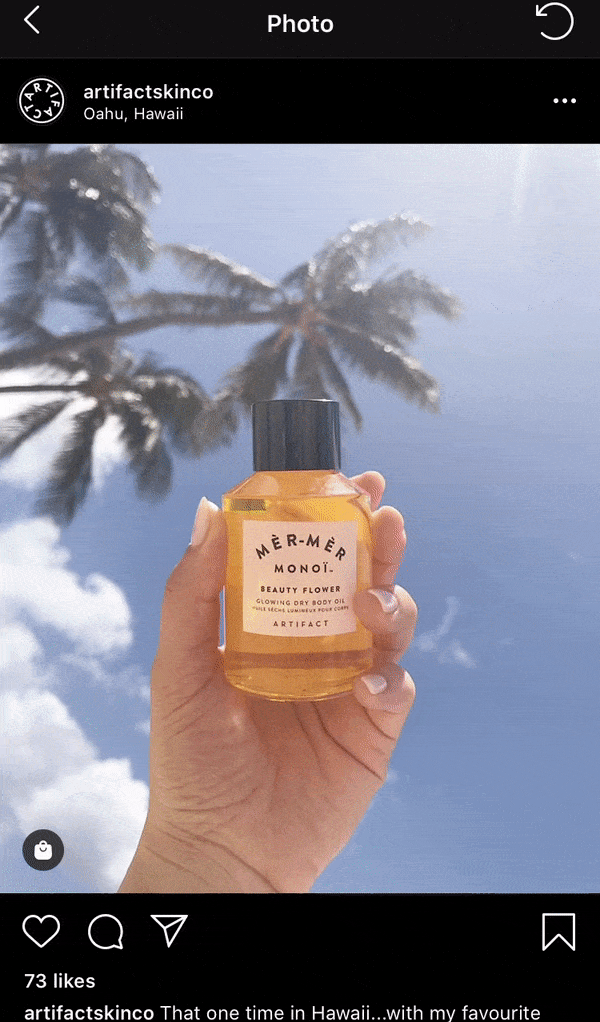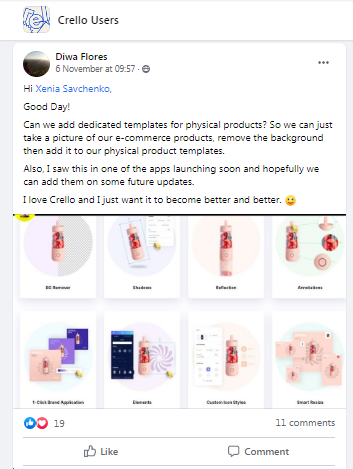And here we are, with 2021 in full swing. While we have already identified a few bits and bobs to try out on social media this year, there are still more to come. In fact, some social media platforms and new inventions have been popping up like mushrooms early in 2021.
Social media trend #1: The rising importance of micro-communities
During the F8 conference in 2019, Mark Zuckerberg said that “groups are now at the heart of the experience”. And while he only mentioned his own child – Facebook – it’s also relevant for general micro-communities, whose importance is expected to grow.
Facebook Groups, LinkedIn groups, Messenger group conversations, private Slack channels, and even Reddit subtopics: they are all communities on a micro level.
Companies are increasingly more interested in building a community around their brands, and social media profiles alone are not enough to do so. The native features of social media platforms encourage forming communities – which is one of the social media trends we’re eager to identify.
Micro-communities come with many benefits:
They can be used for early idea validation, as well as getting product feedback.
You can conduct market research on a microscale among your loyal community of customers and people caring about your brand. The feedback you can get via micro-communities can’t be underestimated and is impossible to get anywhere else.
A single question might spark discussion about the products or even raise the urge for changes that you never thought you needed to implement. While it’s not a social media trend itself, it shows you a direction to follow.
How can you use these trends in social media in 2021?
Let’s assume that you run a clothing brand. By building a community around your products, you encourage members to share their deliveries from your brand, and exchange feedback or advice – as the social psychology concept claims.
But you can also use the community to help create new offerings. Your clients may talk about new products that you don’t currently offer (e.g. maxi dresses), and this presents a big opportunity for you to consider and apply.
Communities are characterised by deeper engagement, loyalty, and a unique bond between their members and the brand that runs them. They often become the very first places where certain consumers head to upon the purchase or delivery of a new product.
There’s a real sense of exclusivity in micro-communities. In order to be successful, brands should provide communities with premium content and offers. This can in turn pay off with extraordinary engagement, high conversion of community members, and an abundance of data.
As one of social media trends 2021, we’re expecting brands to grow their social media micro-communities, set up new ones, dig out the forgotten communities they once had, and interact with existing communities around their industry.
Try Kontentino for free
Sign up for a 14-day trial of Kontentino and stay on top of your social media marketing in 2021.
No credit card required!
Social media trend #2: Short-form videos are here to stay
You may think that you’ve seen it all before. Yet Snapchat revolutionized social media a few years ago before passing the baton over to Instagram Stories, which, along with Instagram feed, brought short videos to many companies’ strategies.
What else will be here to say, then?
Ask TikTok.
TikTok has changed the already established market of short-form videos. It quickly got Generation Z’s attention first, before spreading to other video creators, making one of the most important trends in social media in the last few years.
And suddenly, everyone had to explore TikTok.
While what’s going on with the tool is unsure (in the light of a ban in some countries), the truth is that short-form videos are here to stay. Other social media platforms are jumping on the bandwagon of short videos’ popularity and making the most of this social media trend.
Instagram responded to TikTok’s hype and consumer demand with Reels, which is currently being tested in a few countries. Reels are shorter than TikTok videos, yet they allow users to add music and effects, including AR ones.
Twitter and LinkedIn aren’t being left behind either, launching Stories-like formats on their platforms. With Twitter Fleets, currently in testing, you’ll be able to publish quick stories up to 140 (coincidence?) seconds each, combining videos, photos, and even gifs. LinkedIn Stories, rolling out gradually all over the world, will help individuals build their personal branding and connect with their networks using short videos.
As one of social media trends in 2021, we’re expecting not only to see more platforms roll out new short video features, but also more brands investing their time and resources in this kind of communication.
Social media trend #3: Further development of conversational marketing on social media
Conversational marketing won’t only mean chatbots and automated rules in 2021: it will mean conversational commerce, analyzing customer journeys via multiple touchpoints, and solving more than just common problems.

RCS (rich communication services), push notifications, voice-activated assistants, and chatbots: they all use and leave breadcrumbs of information that can help with delivering an even better customer experience. And according to our prediction for trends in social media 2021, brands won’t want to possibly miss out on that.
With Facebook itself developing new ways to automate customer service on the platform (common inbox and automated rules, just to name a couple), Instagram pushing Reels, and Twitter allowing for voice Tweets, the movement is visible.
As one of social media trends 2021, we’re expecting brands to consider implementing both chatbots and solutions for conversational marketing, as well as technology to catch up with, if not surpass, conversational marketing demands.
Try Kontentino for free
Sign up for a 14-day trial of Kontentino and start preparing and sharing your social media content the smart and simple way.
No credit card required!
Social media trend #4: Emergence of new shoppable formats
2020 forced many businesses to move online and offer even more digital solutions in order to keep in touch with their clients. It also, indirectly, may have sped up the development of new social media formats that sparkled in 2020.
Take Facebook Live Shopping. Combining live videos with shoppable features give brands another exciting opportunity to showcase their products, and clients can immediately buy them.
And that’s going to be one of the social media trends of 2021: an even tighter link between social media and ecommerce, allowing social media users to browse, research, buy, finalize a transaction, and give product feedback on one platform.
Instagram has also been heading this way. Shoppable posts have strengthened their role since many businesses have had to pivot to exclusively online, or make it their strong branch.
Since their implementation requires as little as having a Business Account and uploading products to Facebook in order to tag them on Instagram, increasingly more brands are deciding to leverage such posts in their communication. Shoppable posts are not the newest trends in social media, yet they definitely have space to shine even brighter.

As one of social media trends, we’re expecting these two formats to keep shining, but also other formats to join forces and support seamless ecommerce on social media.
New and upcoming social media platforms in 2021
Clubhouse
A total revelation of early 2021 and the main cause of FOMO for thousands all around the world. While Clubhouse had been doing okay in the US during 2020, its opening up in Europe in January 2021 made the world stand up and take notice.
Everyone wanted to get on this platform, but its exclusivity made joining not that easy. Before we dig deep into the details, let’s take a closer look at what Clubhouse is and what’s behind the phenomenon.
What is Clubhouse?
Clubhouse is an innovative social media format since the application is based 100% on voice. Of course, you can create your own profile there, add a bio, and make friends, but the whole concept is centered around audio conversations. The app itself describes itself as “a new type of voice-based social product [which] allows people around the world to talk, tell stories, develop ideas, deepen friendships, and meet interesting new people around the world.”
People like to compare it to an interactive radio or podcast that is ready to listen to at any time. The idea has certainly gained popularity with the audience present there too, including celebrities and influencers who are difficult to reach on a daily basis let alone converse with.
The list includes celebrities such as Elon Musk, Oprah, Jared Leto, Drake and Ashton Kutcher, as well as leading journalists, members of the Forbes billionaires list, Dragon Den’s entrepreneurs, and top marketers in Silicon Valley.
Besides them, the portal’s exclusivity alone makes it worthwhile because it is not for everyone.
Clubhouse is currently available only in the Appstore, but you need more than just an iOS device to join – you also need an invitation from an existing Clubhouse user. The name of the person who invited you is displayed in your profile after registering. Importantly, if you break the rules of the community and receive a penalty, the person who invited you will also be punished.
Clubhouse has its own algorithm that you need to deal with. You can choose from a wide range of topics you’re interested in when creating a profile. This, in a way, defines the content – in terms of rooms or clubs – that will be displayed to you. However, your friends have a huge impact on the rooms or clubs that you can see too, as ones joined, created, or planned by anyone you follow will also be shown.
What makes it special?
It’s all about talking here! When joining someone else’s room, you can either remain a silent listener or participate in the discussion by invitation from the moderator or by raising your hand and obtaining their consent. You may set up rooms of your own (Start a room) that anyone can join, and then you can decide if you want them to join the discussion as a speaker or name them a moderator.
Of course, you also have notification and search engine sections too.
The feature that really distinguishes it from other social networking sites is its synchronization of communication. Synchronous communication, as opposed to asynchronous communication (which can be answered at any time), requires authenticity, commitment, presence, and awareness. All of these characteristics make the contacts established by Clubhouse seem more genuine. This contrasts with the sense of a disconnect from reality that we have generally all experienced in recent months due to excess online communication. We are hungry for communication, for a presence that is even remotely similar to what is natural. The past year means that we are probably all tired of asynchronous consumption of digital content, so we are looking for authenticity and spontaneity.
As it happens with the social mediums, the key here are early adopters of technology and heavy users of social media. Therefore, most discussions revolve around business, technology, marketing, and social media, although more niche topics do also find their place there.
Clubhouse works wonders as a channel for brand communication, building expert authority, and growing communities. It is also the perfect place to search for and interact with potential and current clients, especially early adopters – early users who are well versed in new technologies and business. This may be the “one” tool to reach young, active, and trend-following customers.
In 2021, we expect many founders to include Clubhouse in their market entry strategies – from researching the market potential of products targeted at these groups to educational and image-building activities, as well as product launches themselves of course.
Snapchat Spotlight
According to several reports, Snapchat is still going strong among Generation Z, and not only them. Snapchat introduced a new feature called Snapchat Spotlight that helps it compete with other social media platforms.
What is Snapchat Spotlight?
Spotlight is nothing more than a special place in the application where you can upload and watch vertical video materials on a created channel. The videos are supposed to last up to 60 seconds, and the creators receive money for each view.
No surprise that you can make use of all Snapchat’s features – filters, lenses, and other tools – to help create videos for Spotlight.
This format resembles TikTok, and the similarity is intentional since Snapchat wants to fill the void left by potential TikTok’s expulsion from various markets. Since Snapchat gives away one million dollars every day to Spotlight creators, there’s a lot for users to gain. A complex formula is used to determine the amount of revenue a video generates for the owner, but it does take into account the number of views the video receives.
For Snapchat, it doesn’t matter whether content is published by an influencer or a private individual – so everybody can give it a go.
The new Spotlight feature will use an algorithm to recommend the “most engaging” posts to view based on what interests each user. They will measure user interest as well as the popularity of and likes that the content receives. Algorithms will also check the time spent viewing the material, with Snapchat indicating that skipping videos will also be factored in. The emphasis, therefore will be on providing users with new videos they have not yet seen but may be interested in.
There is no requirement to have a large number of followers to earn money – your videos just have to become popular. With Snapchat, popularity is determined by unique impressions, so if you have new people checking out your content then your chances of earning a share of the whopping $1 million daily will increase. According to Snapchat, Spotlight will be developed based on user feedback.
Bebo
Let us just mention Bebo, which is rising from the ashes like a phoenix. While for many it will be a brand new platform (already in beta version, exclusive to testers), others may remember about its rise and fall in popularity during the 00s.
Back in 2007, Bebo (Blog Early, Blog Often) surpassed both Facebook and MySpace as the UK’s most visited social networking site. Yet, after numerous twists and turns, it filed for bankruptcy in 2013 before managing to relaunch in 2015. Then, In 2019, Twitch – the video streaming platform owned by Amazon – acquired Bebo before closing it down again.
Quite a rollercoaster. And now, Bebo is making another comeback sixteen years after it was first created.
A basic profile page for a Bebo user used to include two modules: a comment section, where other users can post messages, and a list of the user’s friends. Whenever a user’s profile was updated, their friends could be notified. Users could add additional modules, pictures, video, questionnaires, and forms to their profile pages on Bebo.
How’s the new Bebo 2.0 going to work? Only beta testers know the answer to that for now, but it’s been confirmed that the old data from Bebo won’t be retrieved.
Is that it?
Of course not. The reset of the year 2021 will bring even more novelties and platforms, many of which may follow in the footsteps of Clubhouse. TikTok is partnering up with Spotify and Samsung, Reels are getting more popular, plus Facebook and Instagram are already planning some kind of Clubhouse copies with 4-person audio/video rooms. One thing is for certain – we won’t be bored in 2021.





